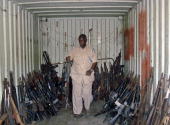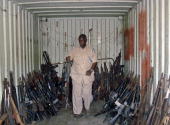German Small Arms: The Nigeria-Connection

 |
| Cache of Arms |
German-Nigerian military cooperation already started shortly after Africa’s most populated country gained independence in 1960. The state-owned company Fritz-Werner was contracted in 1963 by the Defence Industries Corporation (DICON) to set up a factory for the production of small arms and ammunition in the northern city of Kaduna. Fritz-Werner supplied the ma-chinery for the licence production of BM59-rifles of the Italian brand Beretta as well as for ammunition of the calibres 7,62 and 9mm. The British High Commission in Lagos reported to London that the managers from Geisenheim – an idyllic town at the River Rhine - paid mas-sive bribes boosting corruption to new dimensions.
Then, from 1967 to 1970, hundreds of thousands of people were killed in East-Nigeria during the Biafran War, according to some estimates, even up to two million. Fritz-Werner played a decisive role in the victory of the central government over the secessionists, since a team of the company ensured the continuation of the production in Kaduna. British documents give evidence that the German director-general of the plant purchased G3-kits through the com-pany Interarms which belonged to the notorious arms dealer Sam Cummins. Furthermore, Fritz-Werner took over the maintenance of the Nigerian Air Force’s Dornier-planes on behalf of the West German government. In late 1967 the Foreign Office in Bonn gave green light to Fritz-Werner and its rival company Dynamit-Nobel, a subsidiary of the Flick-group, for the export of 3 million rounds of ammunition (7,62mm) each. When it denied the sale of another 3 million rounds in 1968, Fritz-Werner simply realized the deal via a third country.
In 1976 DICON awarded Fritz-Werner with a follow-up contract to modernize the plant and to set up the production of the Nigerian Rifle (NR). The West German Foreign Office gave green light for this enterprise despite H&K claiming that it was a non-licensed production of the G3. Fritz-Werner was able to convince the diplomats that the NR was based on another type of rifle. This was apparently the FAL of the Belgian manufacturer FN Herstal, which strongly resembles the G3. According to the small arms expert Dr. Edward Ezell, DICON purchased the licence rights in 1977. He writes that technicians of Fritz-Werner remained active in Kaduna during most of the Eighties. The CIA-Factbook noted that the production reached its full capacity of 15.000 FAL per year in 1987 while the manufacturing of BM59-rifles continued.
According to Ezell the Nigerian Army also bought large amounts of G3s, ca. 6.000 HK21 machine guns as well as MP5 machine pistols. H&K had them assembled by its English part-ner Royal Ordnance in Enfield and Nottingham in order to circumvent German export restric-tions (see my recent article “Germany’s Unseen Hand in Kenya Crisis” at www.africanexecutive.com/modules/magazine/articles.php?article=2868). The Geneva based think-tank Small Arms Survey has reported that Nigeria passed some of the G3s on to Sierra Leone. This explains why UN-disarmament programmes after the civil war (1991-2000) counted the G3 as the number two rifle. A realistic picture of the G3 in Sierra Leone is given in the movie “Blood Diamond.”
The DICON-plant in Kaduna may have come to a near standstill during the Nineties, but ac-cording to the highly reputable Jane’s Intelligence the G3 - nicknamed “Shettima” (after the first G3-version “CETME”) or “Shaka-bola” – as well as FAL, BM59, MP5 and HK21 are still standard weapons of the armed forces. In the meantime many of them have fallen into the hands of criminals and insurgents. In 2001 the General-Auditor Dr. Vincent Azie concluded his investigation into the police that numerous G3 had disappeared from its depots. A study of the University of Bradford shows that the proliferation of small arms has become endemic since 1999.
Since the dramatic escalation of the crisis in 2004, there has been an increasing number of Nigerian press reports about shootings that involved G3s in all parts of the country, especially in the Niger-Delta, the former Biafra. The International Crisis Group reported in 2006 that the rebel Niger Delta People’s Voluntary Force had equipped itself with G3s. In August of the same year, fire-exchanges in the city of Umuahia between police and attackers, who were armed with at least one G3, claimed a number of casualties. In 2007 there were reports about G3-supplies to militants of the Niger Delta Strike Force. And just a few weeks before the bloodbath of this New Year’s Day in Port Harcourt, a number of G3s had been confiscated by the police from insurgents. The German mass media - despite greatest concerns about the rocketing price of oil - ignored all of these G3-incidents completely. Unfortunately, it has to be assumed that even the Nigerian press reports only highlight the tip of the iceberg with re-gard to the disastrous role of German small arms.
